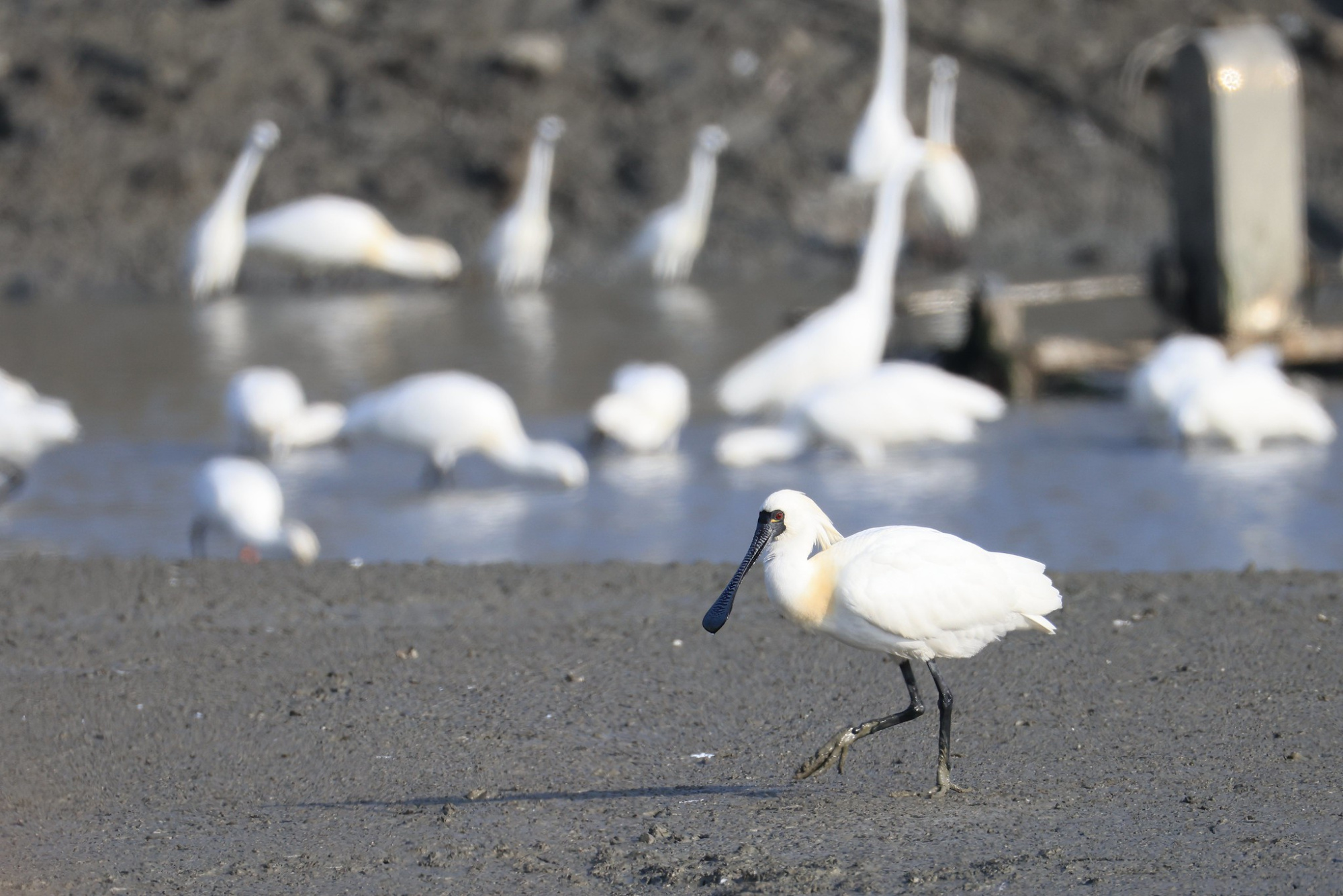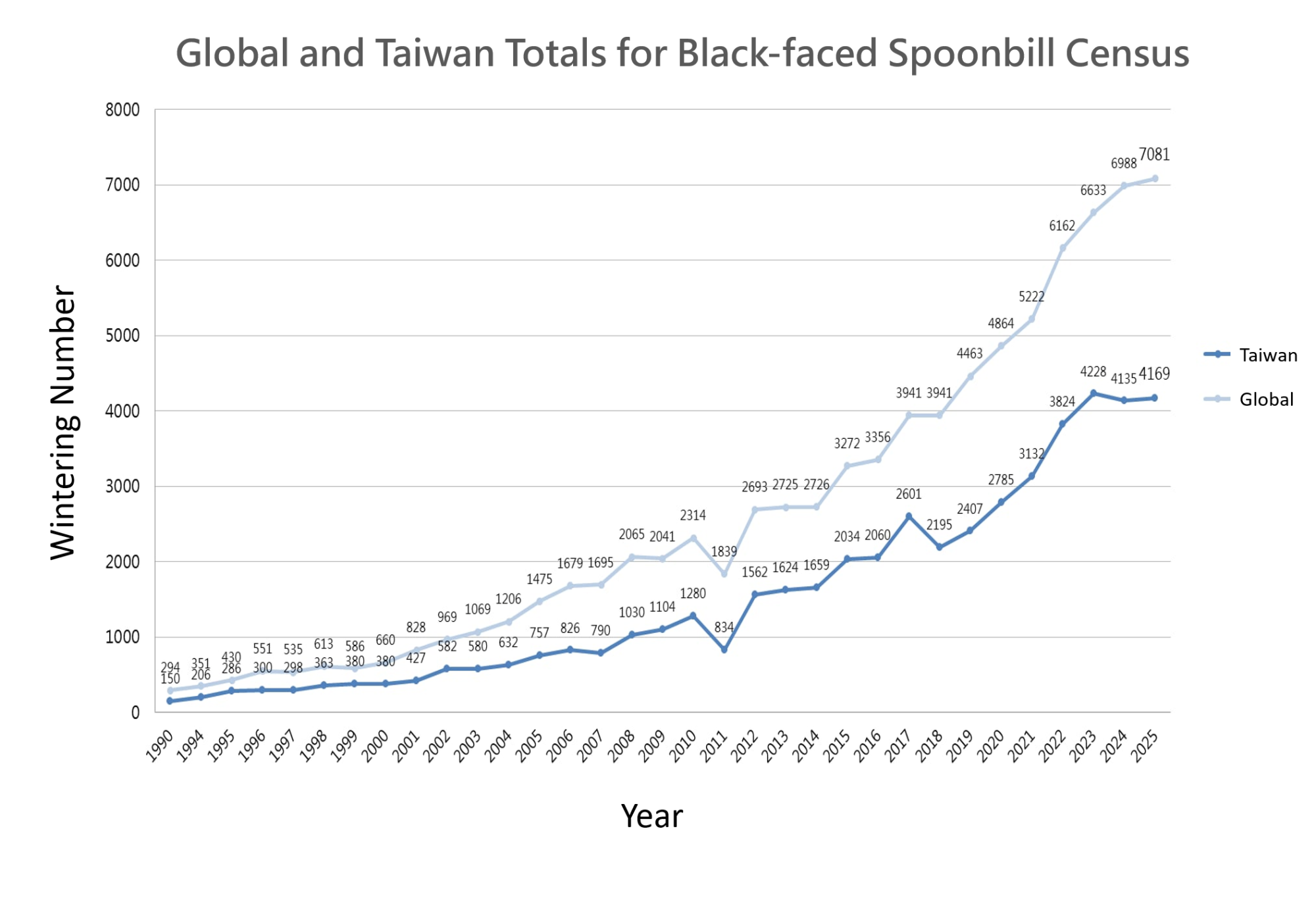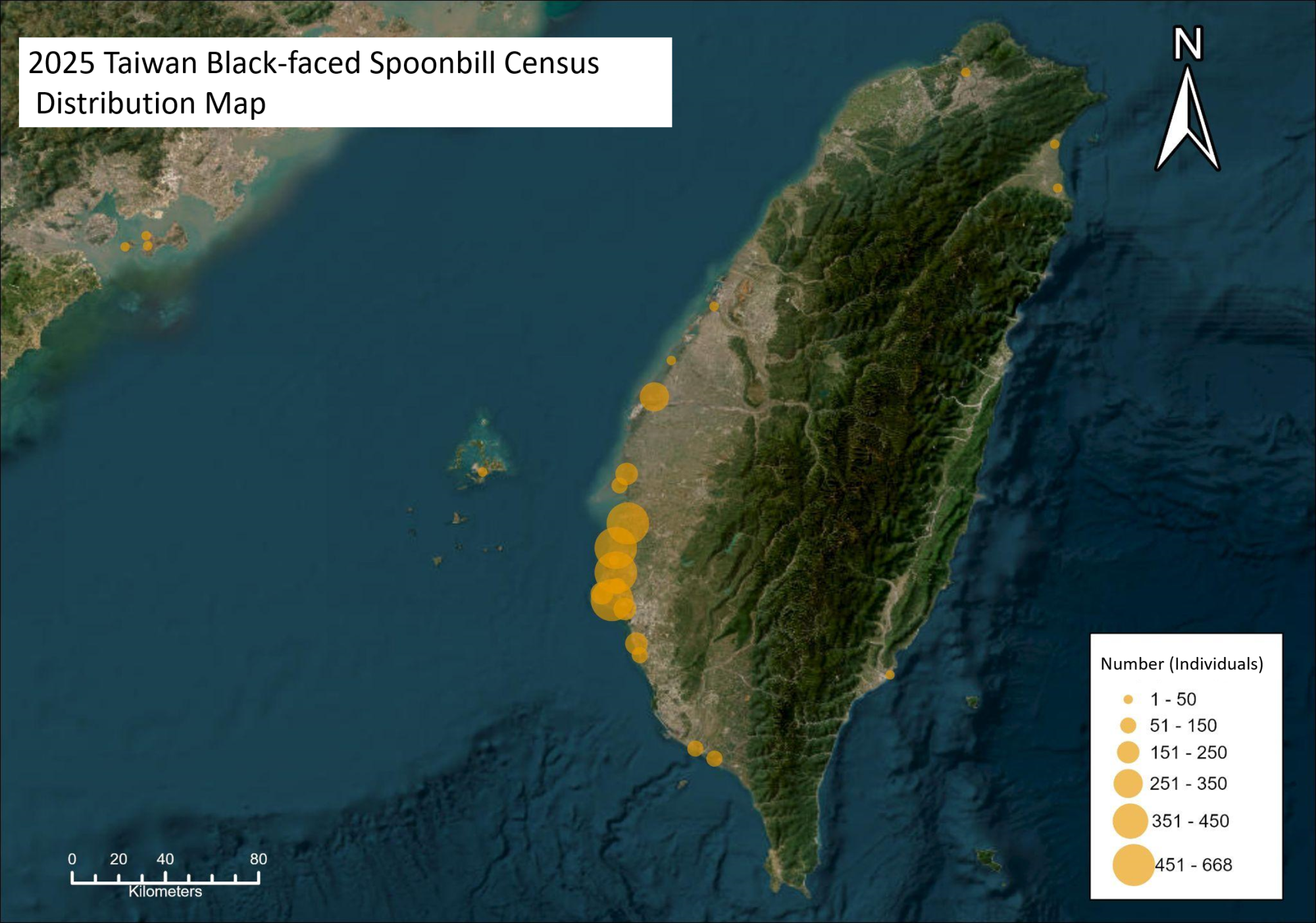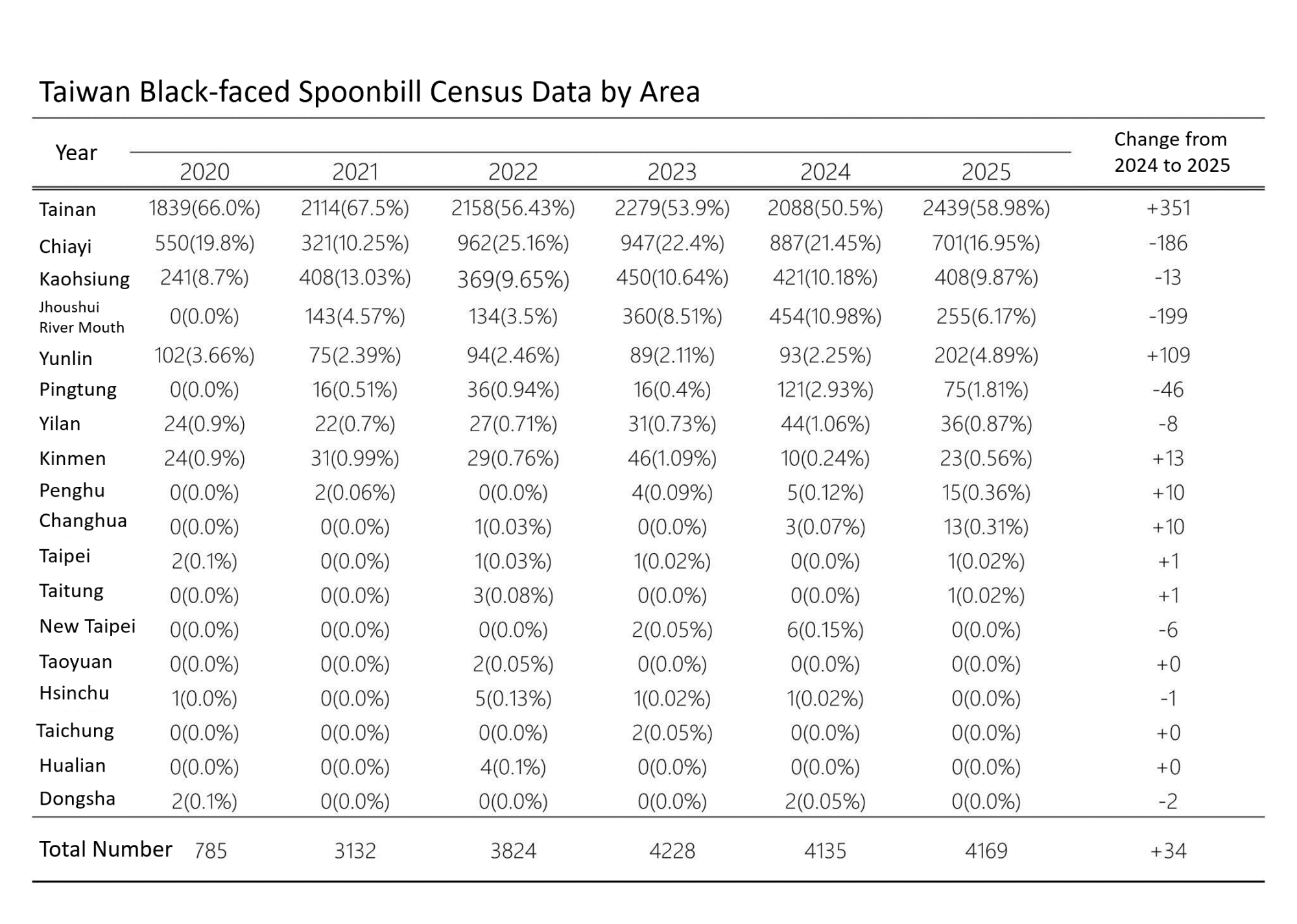Global Population of Black-faced Spoonbill Surpasses 7,000 But Growth Stagnates

Photo: Allen Lyu
Global Census Overview: Record High, but Growth Slowing
The results of the 2025 International Black-faced Spoonbill Census were released in early April. This year, a total of 7,081 Black-faced Spoonbills were recorded worldwide, marking the first time the global population has surpassed the 7,000 threshold. In Taiwan, 4,169 individuals were recorded, a slight increase of 34 from the previous year. According to the organizer of the global census, the Hong Kong Bird Watching Society (HKBWS), overall growth for the population has clearly slowed, suggesting the species could possibly be reaching its saturation point. This is consistent with Taiwan’s census results in recent years, underscoring the urgent need for ongoing habitat conservation.
The global synchronized census, which is conducted annually along the East Asian–Australasian Flyway, was held January 18-19. In Taiwan, the survey was coordinated by the Taiwan Wild Bird Federation (TWBF) in collaboration with local partner organizations and over a hundred volunteers. Financial support was provided through the “Green Ecological Network” project managed by the Forestry and Nature Conservation Agency, Ministry of Agriculture. Taiwan’s numbers accounted for 58.9% of the global population and reaffirmed its role as the species’ most important wintering site. Other major wintering areas included China with 1,671 individuals (23.6%), Japan with 716 (10.1%), and the Deep Bay area of Hong Kong and Shenzhen with 328 (4.6%). Additionally, Vietnam recorded 112 birds (1.6%), South Korea recorded 52 (0.7%), the Philippines recorded 17 (0.2%), and Macau recorded 16 (0.2%). Compared with last year, the global total increased by 93 individuals.
Regional Distribution in Taiwan: Increase in Tainan City, Fluctuations at Key Sites
In Taiwan, more than 90 percent of the Black-faced Spoonbill population winters along the southwestern coast. This year, the distribution by city and county ranging from highest to lowest was as follows: Tainan City (2,439), Chiayi County (701), Kaohsiung City (408), the Jhuoshui River Mouth (at the border of Changhua and Yunlin counties) [255], and Yunlin County (202). Smaller numbers were recorded in Pingtung County (75), Yilan County (36), Kinmen County (23), Penghu County (15), Changhua County (13), and New Taipei City and Taitung County with one individual each. Compared to last year, Tainan saw an increase of 351 birds while Yunlin County gained 109. Meanwhile, the number counted at the Jhuoshui River Mouth decreased by 199 individuals. Other places where numbers went down included Chiayi County (186), Pingtung County (46), and Kaohsiung (15). While overall, national totals remained steady, the proportion of birds recorded at different localities has shifted significantly. These fluctuations are generally linked to changes in foraging conditions at key sites during the census period.
It is worth noting that in recent years, Changhua and Penghu counties—areas which historically recorded very few wintering Black-faced Spoonbills—have begun to show more consistent winter sightings. In addition, data from eBird indicates regular observations of wintering individuals outside of the official census period, suggesting a gradual expansion of the species’ wintering distribution in Taiwan.
Habitat Pressure Intensifies: Shrinking Areas and Quality Concerns
According to the 2024 Red List of the Birds of Taiwan published by the Taiwan Biodiversity Research Institute, Ministry of Agriculture, the Black-faced Spoonbill was uplisted to “Nationally Vulnerable” from “Nationally Near Threatened” due to ongoing threats, with habitat loss posing the most concern.
In recent years, several fishponds in Tainan City that once provided stable foraging grounds have been rezoned as “aquaculture–photovoltaic co-use” sites. The expansion of PV installments within these areas has reduced the availability of shallow-water foraging areas, contributing to shifting wintering patterns. Long-term monitoring conducted throughout the wintering season by the Wild Bird Society of Tainan (WBST) and the Taiwan Black-faced Spoonbill Conservation Association has shown noticeable declines in some traditionally important areas, and increased numbers in areas that previously held smaller flocks.
In addition to shrinking habitat, habitat quality issues also remain. According to statistics from the WBST, between October 2024 and March 2025, a total of 75 Black-faced Spoonbill rescue reports were filed in Tainan City alone. Most were suspected to involve botulism poisoning. The number of cases remains similar to that of previous years, suggesting that environmental conditions—or other unknown factors—continue to pose serious health risks to the population.
Working Together to Protect Black-faced Spoonbill Habitat and Advance Toward a Nature-Positive Future
Looking ahead, the United Nations Convention on Biological Diversity has set a global goal of achieving “Nature Positive” outcomes by 2030, with the aim of reversing biodiversity loss and promoting ecological recovery. While the Black-faced Spoonbill’s global population has grown and its wintering range appears to be expanding, challenges such as habitat loss, declining environmental quality, and disease are becoming more widespread and complex. As a flagship migratory species and a key indicator of wetland health, the conservation of the Black-faced Spoonbill is closely tied to the broader sustainability of Taiwan’s ecosystems. Protecting its habitat not only benefits the species itself but also contributes to the long-term resilience of wetland biodiversity. Addressing these challenges will require joint efforts from government agencies, the private sector, local communities, and civil society organizations. Only through improved national land-use planning, promotion of ecologically friendly practices, stronger disease monitoring and prevention systems, and increased public awareness can we ensure that the Black-faced Spoonbill—and the wetland ecosystems it relies on—will continue to thrive. In doing so, Taiwan can play a vital role in advancing the global toward a nature-positive future.
Acknowledgments
We would like to thank the following organizations for their invaluable support in conducting the survey: Wild Bird Society of Keelung, Wild Bird Society of Taipei, Wild Bird Society of Taoyuan, Wild Bird Society of Hsinchu, Miaoli Nature Ecology Society, Taiwan Wild Bird Federation, Wild Bird Society of Changhua, Wild Bird Society of Yunlin, Wild Bird Society of Chiayi, Wild Bird Society of Tainan, Taiwan Black-faced Spoonbill Conservation Association, Wildlife Conservation Institute of Tainan City, Kaohsiung Wild Bird Society, Chiehting Ecological and Cultural Association, Wild Bird Society of Pingtung, Wild Bird Society of Yilan, Wild Bird Society of Hualian, Wild Bird Society of Taitung, Wild Bird Society of Kinmen, and Wild Bird Society of Penghu and other groups that assisted with the census.
Funding Support
We gratefully acknowledge the support of the Forestry and Nature Conservation Agency, Ministry of Agriculture, and Taijiang National Park.



